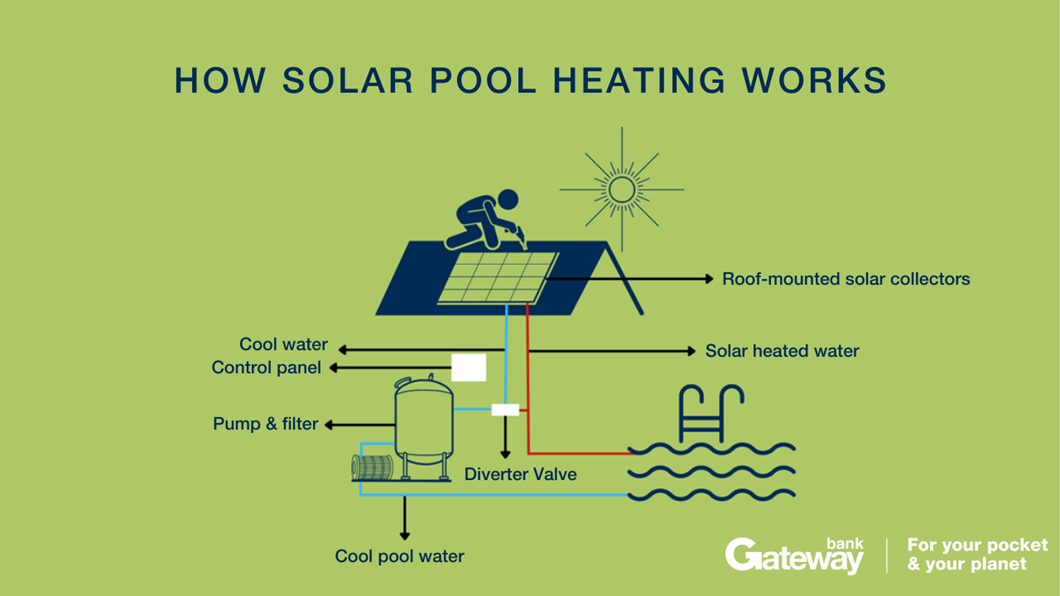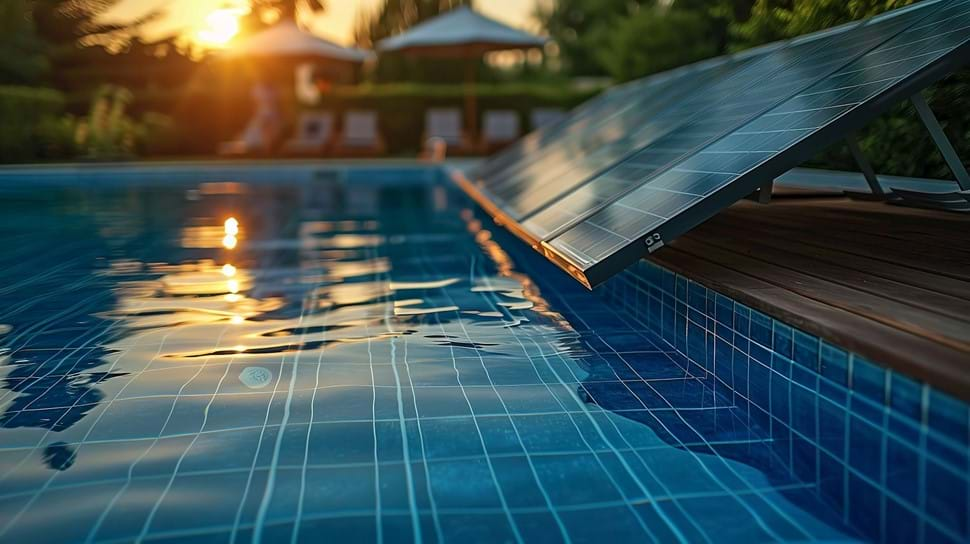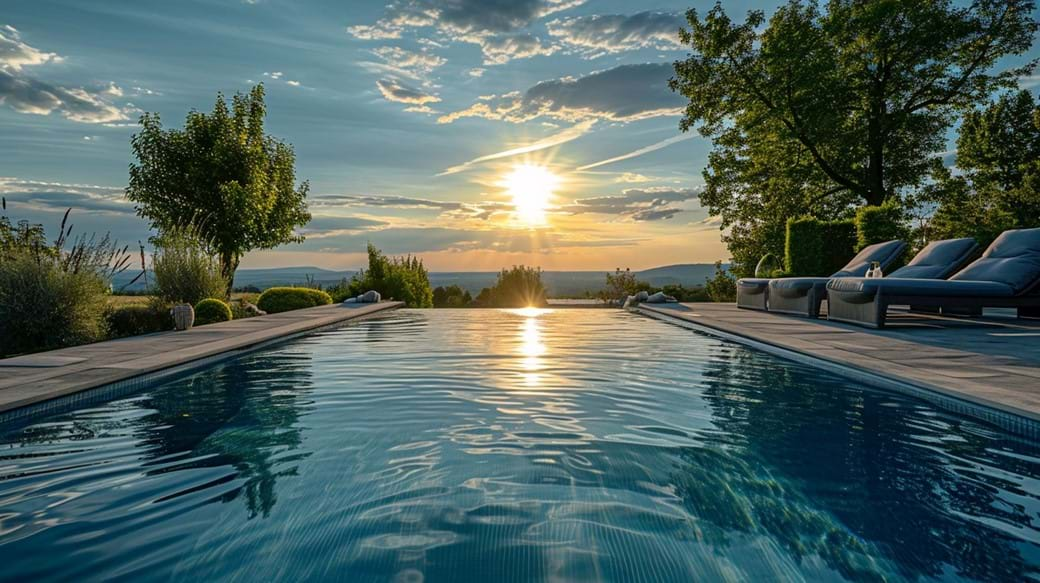Looking for an energy efficient way to heat your pool? A solar pool heating system may be the answer. We’ve compiled the information below to provide the basics of solar pool heating. If you are looking to install a system at home, it’s important to conduct your own research and discuss your needs with a certified provider.
What is a solar pool heating system?
Solar energy is the sun’s power which is light and heat. Solar pool heating systems collect pool water through a pump, then the solar system collects the sun’s energy to heat the water and pump the heated water back into the pool. Solar pool heating systems are usually placed on the roof of a house or building (e.g. a shed).

Three common types of solar pool heating systems
-
Strip solar pool heating
Strip systems consist of long, narrow strips or tubes made of a flexible material, such as rubber or PVC. These strip solar collectors are installed on a roof. To heat the pool water, a solar pump collects water from the pool into the tubes where the solar strips collect the sun’s energy which heats the water. The heated water is pumped back into the pool.
-
Rigid panel solar pool heating
Rigid panel systems consist of solid panels made of plastic or rubber materials. They usually have channels or tubes through which the pool water flows. A solar pump collects water from the pool into the tubes where the solar strips collect the sun’s energy which then heats the water. The heated water is pumped into the pool. Rigid panels are larger and more rigid compared to strip systems and are usually installed on roofs.
-
Evacuated tube solar pool heating
Evacuated tube collectors are composed of rows of glass tubes and a heat pipe that absorbs sunlight from multiple angles throughout the day, which makes them efficient in less sunny or colder climates. The sunlight creates steam that rises to a rod at the top of the tube. The heat is transferred to water in a pipe at the top of the tubes which is circulated back into the pool. They are typically mounted on the roof or ground and require a sturdy frame for support.
How do I control the temperature of my pool?
Solar pool heating systems have a controller that checks the current temperature of the pool and the roof to see if it’s warm enough to heat the pool water. You can use the controller to set the desired temperature of the pool water. Once it’s reached, the controller will stop the heating system.
Things to consider before installing a solar pool heating system
Before installing a solar pool heating system, discuss the following factors with your provider as they may affect the performance of the system. Your provider should mention any other considerations specific to you.

-
Your climate zone
Consider the average temperature of where you live. Areas that are warmer and receive a lot of sun will see the solar system work most effectively. If you live in an area that is cooler and doesn’t always receive a lot of sun, you might need to install extra solar collectors and use a solar pool cover in conjunction with the heating system to retain the heat in the water.
-
The size of your roof and pool
Australia’s sun path is to the north. If your roof is north facing, solar collectors will capture the most sunlight if placed there. The size of your roof will affect how many solar collectors you can place on it. If your pool is larger, it may take longer to heat so you could need more solar collectors.
Obstructions in the form of trees, debris on the roof or surrounding buildings can also affect how much solar energy is collected.
-
The material your pool is made from
If your pool is made from concrete, it’ll take longer to heat the pool water and maintain the heat, meaning a stronger solar system is required. Pools made from fibreglass do not take as long to heat and can retain heat better than concrete.
What are the benefits of solar pool heating?

-
Extended swimming season
You don’t have to wait for summer or spring to use your pool, you can use it all year round!
-
Energy efficient and environmentally friendly
The sun’s energy is free and clean, reducing the need to use energy that produces emissions to warm the water. You will need electricity to operate the water pump.
-
Low maintenance
You will need to routinely check if the system and components are intact, and the surrounding areas are not affecting the performance of the solar collectors.
What are disadvantages?
-
Initial cost
There will be an initial cost with buying the solar pool heating system. To determine if it’s worth it, consider how often you use your pool.
-
Reliance on good weather and can’t be used at night
Solar pool heating systems rely on sunny weather to work. They won’t work well when its overcast or raining. You also can’t use the system at night. Solar pool heating systems don’t have compatible battery systems to store the excess energy generated.
More ways to improve your homes energy efficiency
Solar pool heating systems offer a range of benefits for pool owners in Australia. From cost savings and environmental sustainability to an extended swimming season, these systems provide an efficient and eco-friendly way to heat your pool.
If you’re looking at other ways to make your home more energy efficient, you can read some of our helpful articles:
- How External Awnings Can Improve Your Home’s Energy EfficiencyRain and storm water tanks – a beginner’s guide
- Rain and storm water tanks - a beginner's guide
- 5 Steps Towards a Zero-Waste Home
- Tips for Reducing Waste at Home
- Your Ultimate Guide to Building an Eco-Home
You may be eligible for Gateway’s Green Home Loan
By making your home more energy efficient and reducing its impact on the environment, you may qualify for our discounted Green Home Loan. Our Green Home Loans reward members who want to adopt a more sustainable lifestyle with a discounted interest rate.
Apply online today or speak to our member services team to find out more.





